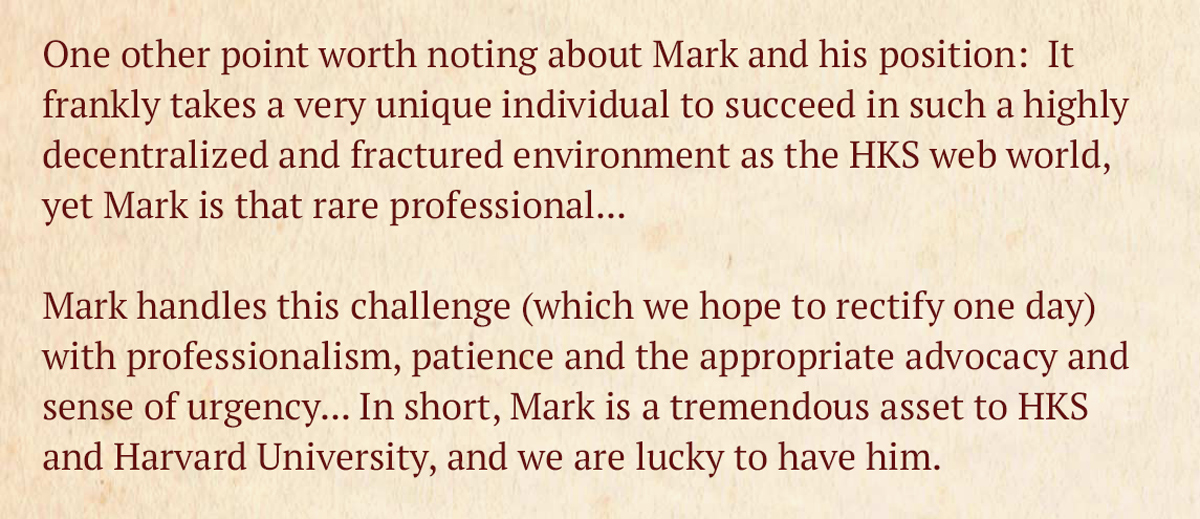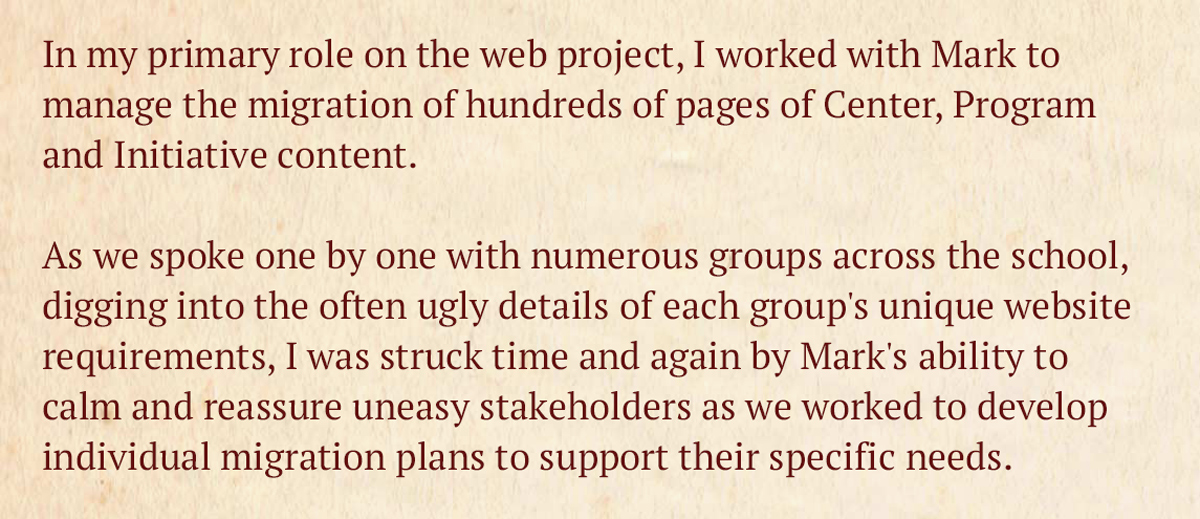Digital Leadership
Harvard Kennedy School & Harvard University

From command lines to first-ever tweets, CSS rules to CMS templates, site build-outs to budget projections, content strategy to design to analytics to re-platforming to community leadership.
I did it.
For a decade, I directed web and digital strategy at Harvard's graduate school of public policy, the Harvard Kennedy School.
My first week at Harvard’s Kennedy School was the week of the 2008 U.S. Presidential election. It’s no understatement to say that the Kennedy School (being the pre-eminent school of public policy and governmental studies in the world) was an absolutely remarkable place to be at that moment.
In the weeks and months after, I received an unforgettable introduction to politics, scholarship, higher education, and the emerging role digital technology could play in bringing them all to new places.
Over the ensuing 10 years, my job never became less fascinating than it was during that dynamic first week. My time as Associate Director for Web Strategy at Harvard Kennedy School is a career-defining experience that I will always be grateful for.
When I was hired, in late 2008, Harvard Kennedy School had recently completed a primary website revamp. The process that produced the site had taken a toll on HKS – the new web platform was live, but budgets, vendor relationships, and internal departmental dynamics were incredibly strained. What’s more, due to a combination of internal politics and technological fatigue, the new site only hosted some of the school’s digital content. Only certain administrative departments and a few centralized databases (like course listings) had homes on the new web platform. A large percentage of the remaining content was locked up in legacy websites, some ten or twelve years old. I was immediately asked to step into a leadership role for the Kennedy School’s digital and web properties, and to try and expand the new web platform’s reach. My first step was to set about building a framework for sustained success on the web.
Decentralization is the norm at the Kennedy School, at Harvard University, and perhaps throughout all of higher education. Silos, odd interdepartmental relationships, and legacy technologies create a challenging and uneven landscape. Instead of a clear hierarchical reporting structure, large parts of HKS and Harvard are comprised of loosely-tethered, pseudo-autonomous business units. Each unit has their own budget, their own objectives (often driven not by school-wide concerns, but by faculty or donor directives), and often their own brand identity.
When I began, most of these units also had their own completely bespoke websites. And they were not in good shape.
It quickly became clear that my role required a particular and uncommon approach: I was being asked by HKS leadership to bring technology, standardization, and best practices to clients throughout the school who clearly needed web help, but often didn’t ask for it – and who didn’t want to give up independence. Without an excess of tools, budget, personnel or precedent, I began to build a network of relationships and partnerships to help this necessary task move forward.

Excerpt from a 2010 performance assessment, as I began to establish success in the decentralized HKS environment.
Within 18 months, I led the migration of three major independent research unit sites to the central HKS web platform. Several dozen such sites would follow over the next 6 years. My approach – a mix of advocacy, training, strategic recommendation and (most importantly) listening – was making progress.
With a background in coding and design, I was often called on to perform hands-on web work during these early migrations. From server administration to writing PHP, HTML, Javascript and CSS to designing graphical layouts and templates, often my direct help meant the difference between a project succeeding or drifting due to lack of technical resources. Over time, I established a school-wide network of content managers, developers, designers and administrators to support these tasks. As successful projects launched, they demonstrated to new stakeholders that technical services were worth budgeting for. By design, the need for my direct participation in coding ebbed. Though my role was always strategic in description, hands-on development was, for a time, a necessary strategic tool.
During this time, my role at HKS grew to encompass leadership. I convened a school-wide affinity group for web and digital users, led training sessions and seminars, frequently reported to school executives and advisory groups, and represented the school at conferences and industry events for digital professionals within Harvard and across the country. I gained experience working with budgets, making projections, and contributing analytics and assessment to briefs and annual documents. In due time, I was asked to take on direct reports, adding a welcome measure of mentorship and management to my role.
Somewhere along the line, I also authored and sent the Kennedy School’s first tweet. (@Kennedy_School now has over 75,000 followers). I recognized the importance of social media early in my tenure, and working with a few like-minded departmental colleagues, I helped create a social media portfolio and strategy for HKS (including a presence on Twitter, Facebook and Youtube) that’s still bearing fruit today.
I won the first of two Dean’s Awards, the highest award bestowed on HKS staff members, in 2014 for my role in leading an effort to bring much-needed upgrades (including a responsive layout) to the school’s by-then aging CMS.
Ultimately, my role at HKS had been building towards one thing: bringing a modern website platform to life. I played a leading role on a school-wide task force charged with planning the next decade of Kennedy School digital priorities. Our report, the HKS Digital Blueprint, ranked a new public website at the top of the priority list. The report was well-received by school leadership.
After several years spent building a budgetary and technological case, funding was allocated to the new website effort in 2015. For the next three years, my role again expanded to include primary strategic and hands-on leadership over this sprawling project, while still maintaining day-to-day responsibility for the older, functioning platform.
I authored the draft of the initial RFP for the project, which was praised both internally and externally for its clarity and sense of vision. Along with a modest project leadership team, I triaged vendor responses, interviewed potential partners, and made recommendations on how best to move forward. I played a leadership role in the formation and direction of what would become a cross-school website project team, and (along with other departmental leaders) served on an advisory group for the project.
For three years, the HKS Public Website Project took up a giant percentage of my professional (and personal) life. I managed budgets, vendors, internal users, and dozens of stakeholder relationships. I reported to executive leadership, created detailed technology plans and managed team turnover. I drafted CMS reviews, content taxonomies, shepherded wireframes, personas, mood boards and mockups towards their ultimate destination – a live, working website. At every step of the way, I was fortunate to work with experienced project managers, detail-oriented reports, capable vendors and visionary leaders from whom I learned a great deal.
The work was often difficult. Pulling up and re-establishing the web presence for thousands of pages and dozens of discrete websites is a tricky business. My strategic leadership often included knowing both how to approach the task at hand, and how to work with the individual stakeholders to make sure they understood the vision and future for their digital presence.

Excerpt from a 2017 performance assessment, noting the specific challenges and my approach.
To much acclaim, the new HKS website – a three-year, six-figure, ten-thousand-page – launched in July of 2017. On day one, fifty internal editors, trained by my team, began using the site to publish new content. Along with the rest of the HKS community, I was ecstatic. The platform currently hosts upwards of four million visitors a year, generates significant revenue in the form of executive education enrollment and donor stewardship, and serves as a calling card for HKS around the world. I’m incredibly proud of the new Kennedy school website, and the colleagues I worked with to bring it to life.
As the project neared its conclusion, my family and I made plans to move away from the Boston area. Harvard Kennedy School leadership asked me to stay on and lead the project into a stable, post-launch phase, even if it meant working remotely. I did so.
In the spring of 2018, the new web platform in strong shape, I said goodbye to the Kennedy School. Looking back, it’s hard to believe just how much we accomplished in the digital and web worlds during my time at the School. Given the unique circumstances of advocating for and building out technology in decentralized higher-ed environments, I’m doubly proud of our real and lasting achievements.
Harvard University is an elite environment – a place that challenges all who associate with it. For almost a decade, I served as a digital leader at Harvard’s Kennedy School, building cutting-edge web platforms, directing diverse teams in decentralized, challenging surroundings, and learning from wonderful, smart colleagues. The time I spent at HKS will always be an honor and an experience that will serve me well as my career moves beyond Cambridge.